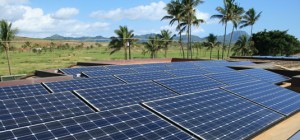 Grid operators on the island of Maui are now routinely “curtailing” wind energy, due to daytime surpluses with so much rooftop solar humming along at the same time that wind peaks. As Utility Dive reports:
Grid operators on the island of Maui are now routinely “curtailing” wind energy, due to daytime surpluses with so much rooftop solar humming along at the same time that wind peaks. As Utility Dive reports:
For the Kaheawa Wind Project, a 51 MW wind installation on island of Maui, curtailment is a fact of daily life. The facility is actually two separate projects — one installed in 2006 and the other in 2012. For KWP II, the latter 21 MW installation, the amount of power not accepted by Maui’s utility can equal amore than a quarter of its annual potential output.
“Last year’s curtailment was on the order of approaching 30% for KWP II,” Steven Rymsha, the plant manager, told Utility Dive during a visit to Maui in March. “That statistic is probably slightly high. It’s in a 25-30% range on a yearly basis.”
30% curtailment is a huge number, and it once again shows why Hawaii is our clean energy “postcard from the future.” Here in California, we will be facing the same problem in the coming years, but we can sell surplus renewables across the west (and import their renewables surplus for our needs).
But Hawaii doesn’t have that option, given its island geography. So why aren’t developers in Hawaii installing energy storage, such as big batteries, to capture surplus energy for later dispatch?
Even as storage prices continue to decline, the MECO grid manager said it remains cheaper for many developers to simply not sell a portion of their power than to invest in a battery and store it.
“To a certain extent, depending on the percentage, curtailment is the cheapest option,” he said. “It’s kind of like if you have a mango tree, you can get all the bottom mangoes sitting under it, and buy a ladder for the middle ones, but you need a bucket truck for the top 10%. It’s probably not worth it.”
I wonder if better rate design or incentives could change this equation significantly enough to encourage more storage deployment. Otherwise, renewable developers will be left needing major price decreases in storage technologies to go that route.
In the meantime, Hawaii should be focusing on the other way to manage this daytime surplus: design rates to encourage energy usage during those peak renewable times and away from non-peak times.
Leave a Reply
You must be logged in to post a comment.


